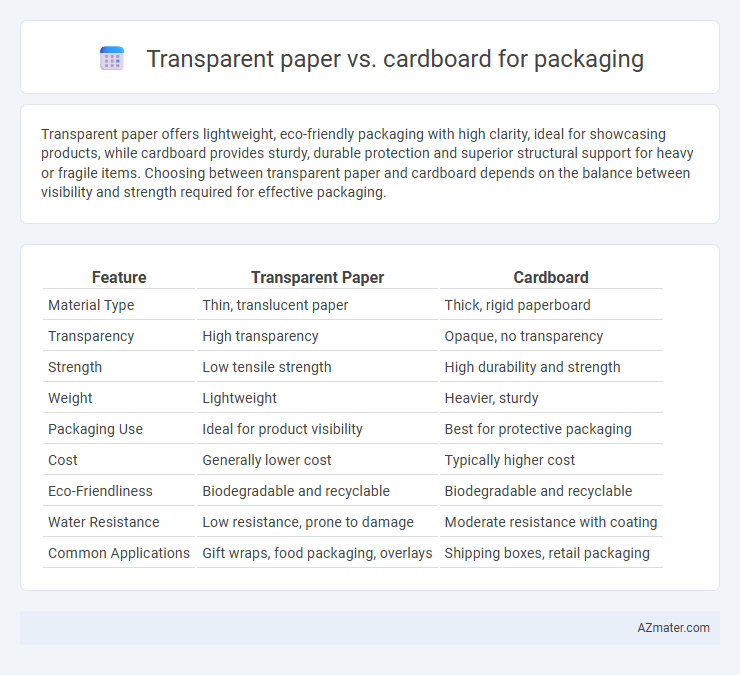Transparent paper offers lightweight, eco-friendly packaging with high clarity, ideal for showcasing products, while cardboard provides sturdy, durable protection and superior structural support for heavy or fragile items. Choosing between transparent paper and cardboard depends on the balance between visibility and strength required for effective packaging.
Table of Comparison
| Feature | Transparent Paper | Cardboard |
|---|---|---|
| Material Type | Thin, translucent paper | Thick, rigid paperboard |
| Transparency | High transparency | Opaque, no transparency |
| Strength | Low tensile strength | High durability and strength |
| Weight | Lightweight | Heavier, sturdy |
| Packaging Use | Ideal for product visibility | Best for protective packaging |
| Cost | Generally lower cost | Typically higher cost |
| Eco-Friendliness | Biodegradable and recyclable | Biodegradable and recyclable |
| Water Resistance | Low resistance, prone to damage | Moderate resistance with coating |
| Common Applications | Gift wraps, food packaging, overlays | Shipping boxes, retail packaging |
Introduction to Sustainable Packaging Materials
Transparent paper offers a biodegradable alternative that maintains product visibility while reducing plastic waste, making it ideal for eco-friendly packaging. Cardboard provides robust protection and high recyclability, supporting circular economy goals through its widespread use in shipping and retail packaging. Both materials contribute significantly to sustainable packaging by minimizing environmental impact and promoting resource efficiency.
What is Transparent Paper?
Transparent paper is a lightweight, translucent material often made from cellulose fibers that allows light to pass through while providing a degree of privacy and protection. It is commonly used in packaging to showcase products without fully exposing them, enhancing visual appeal and preserving freshness. Unlike cardboard, which is opaque and rigid, transparent paper offers flexibility and a sleek appearance suitable for wrapping delicate or visually appealing items.
Cardboard: Properties and Popularity
Cardboard exhibits superior durability, rigidity, and cushioning properties compared to transparent paper, making it ideal for protecting fragile goods during shipping and handling. Its eco-friendly composition from recycled fibers and recyclability contribute to its widespread popularity in sustainable packaging solutions. High customization potential in thickness, printing, and finishes further drives cardboard's dominance across diverse industries including e-commerce, food, and electronics.
Visual Appeal: Transparent Paper vs. Cardboard
Transparent paper offers superior visual appeal by showcasing the product inside with clarity and elegance, making it ideal for items requiring visibility to attract consumers. Cardboard provides a sturdy, customizable surface for branding and intricate graphic designs but conceals the product, which can limit immediate product recognition. Brands prioritizing aesthetic display and product visibility often prefer transparent paper, while cardboard suits those emphasizing durability and brand messaging.
Strength and Durability Comparison
Transparent paper offers moderate strength and flexibility, making it suitable for lightweight packaging, but it lacks the rigidity and impact resistance required for heavy-duty use. Cardboard provides superior durability and structural integrity, ideal for protecting fragile or bulky items during shipping and handling. The dense fiber composition and multi-layer construction of cardboard significantly enhance its load-bearing capacity compared to transparent paper.
Environmental Impact and Recyclability
Transparent paper offers a significantly lower environmental impact compared to cardboard due to its biodegradability and sustainable sourcing from renewable wood fibers without heavy bleaching processes. Cardboard, especially when uncoated and made from recycled materials, remains highly recyclable but demands more energy and water during production, contributing to higher carbon emissions. Choosing transparent paper enhances packaging sustainability by minimizing landfill waste and supporting circular economy principles through easier composting and recycling.
Cost-Effectiveness in Packaging Solutions
Transparent paper offers cost-effective packaging solutions due to its lightweight nature, reducing shipping expenses and material costs compared to traditional cardboard. Cardboard, although more durable and protective, often incurs higher production and transportation costs because of its bulkier weight and material density. Businesses seeking budget-friendly packaging prioritize transparent paper for its balance of affordability and adequate product visibility, making it a practical choice in cost-saving strategies.
Practical Applications and Use Cases
Transparent paper offers excellent visibility for product packaging, making it ideal for showcasing food items, cosmetics, and gift wraps where consumer appeal relies on seeing the product. Cardboard provides superior durability and protection, widely used for shipping boxes, retail packaging, and heavier goods requiring robust support during transit. Combining both materials can optimize packaging design, with transparent paper allowing visibility while cardboard ensures structural strength in multi-layered packaging solutions.
Consumer Perception and Branding
Transparent paper conveys a sense of modernity and eco-friendliness, appealing to consumers who prioritize sustainability and product visibility, enhancing brand trust. Cardboard packaging emphasizes durability and traditional reliability, often associated with premium and sturdy products, reinforcing brand strength and protection. Consumer perception shifts towards transparency for authenticity, while cardboard signals quality and protection, influencing brand identity and purchasing decisions.
Choosing the Right Material for Your Packaging Needs
Transparent paper offers excellent visibility and lightweight protection, making it ideal for showcasing products while maintaining eco-friendliness. Cardboard provides superior durability, structural support, and cushioning, perfect for heavier or fragile items that require secure shipping. Selecting the right packaging material depends on balancing product visibility, protection requirements, and environmental impact to enhance customer experience and brand presentation.

Infographic: Transparent paper vs Cardboard for Packaging
 azmater.com
azmater.com